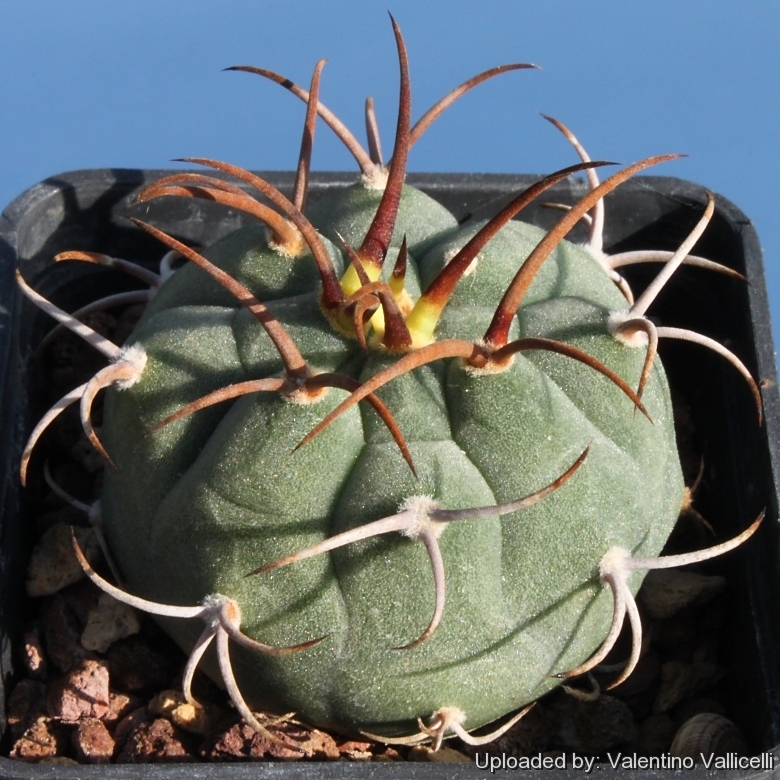= Matucana madisoniorum var. horridispina Kníže
n.n. Karel Kníže seedlist (KK2018 ) "horridispinum"
Accepted Scientific Name: Matucana madisoniorum (Hutchison) G.D.Rowley
Repert. Pl. Succ. (I.O.S.) (Regnum Veg., 87): 10 (1973), without basionym page

Submatucana madisoniorum var. horridispina (Matucana madisoniorum var. horridispina) Photo by: Valentino Vallicelli
Origin and Habitat: Peru (Amazonas)
Synonyms:
See all synonyms of Matucana madisoniorum
back
Accepted name in llifle Database:Matucana madisoniorum (Hutchison) G.D.RowleyRepert. Pl. Succ. (I.O.S.) (Regnum Veg., 87): 10 (1973), without basionym pageSynonymy: 13
Accepted name in llifle Database:Matucana madisoniorum var. pujupatii (Donald & A.B.Lau) G.D.RowleyRepert. Pl. Succ. (I.O.S.) (Regnum Veg., 87): 10 (1973)Synonymy: 3
back
Description: Matucana madisoniorumSN|2238]]SN|2238]] var. horridispina is a morphological form of Matucana madisoniorumSN|2238]]SN|2238]] distinguished from the latter by the stronger curved spines that are always present, all the other characteristics are identical, namely size and shape of stems, flowers, fruits, roots etc. clearly show that they are conspecific.
Habit: It is a solitary globose cactus that may clump with age.
Stem: Flat globular to elongate with age up to 15 cm tall and 10 cm in diameter. One of most endearing feature of this plant is its unusual rough textured blue or grey-green epidermis.
Spines: Sometimes individual plants may be almost entirely spineless, while other specimens are covered with spines or have spines missing on parts of the plant. Seedlings of this species are all densely covered with long, curving spines; however, seedlings from plants growing at lower altitudes will ordinarily lose their spines at maturity, while those from higher altitudes keep theirs, but it is very variable in this respect, and spineless plants can grow spiny offsets, or get just an occasional spine.
Flowers: Zygomorphic tending to lean on one side, bright orange-red, 3,5 cm in diameter, and slightly longer 5-7 (10) cm long.
Blooming time: Flowers more than once in several flushes throughout the summer.
Bibliography: Major references and further lectures
1) E Haustein “Der Kosmos Kakteenfuehrer (the Kosmos Cactus Guide)” Balogh Scientific Books 01 December 1998
2) Edward Anderson “The Cactus family” Timber Press, Incorporated, 2001
3) James Cullen, Sabina G. Knees, H. Suzanne Cubey "The European Garden Flora Flowering Plants: A Manual for the Identification of Plants Cultivated in Europe, Both Out-of-Doors and Under Glass" Cambridge University Press, 11/Aug/2011
4) David R Hunt; Nigel P Taylor; Graham Charles; International Cactaceae Systematics Group. "The New Cactus Lexicon" dh books, 2006
5) Ostalaza, C. & Roque, J. 2013. Matucana madisoniorum. In: IUCN 2013. "IUCN Red List of Threatened Species." Version 2013.1. <www.iucnredlist.org>. Downloaded on 30 October 2013.
Cultivation and Propagation: Matucana madisoniorumSN|2238]]SN|2238]] grow slowly in their natural habitats, but in greenhouses or grafted they grow quickly with tissue that is less firm.
Hardiness: Not very hard to grow if protected from freezing temperature they needs care in cultivation to reach a good size without developing unsightly marks, need a minimum temperature of 10° C, but may survive a light frost.
Exposure: They benefit from a good light but not severe sunlight.
Soil: Grow it in rich, porous soil.
Repotting: Repot in the spring when their roots become cramped. Generally, they should be repotted every other year in order to provide fresh soil. However, this doesn't necessarily mean they'll need larger containers. After repotting, do not water for a week or more.
Waterings: Water sparingly from March till October, the thin, fibrous roots suffer if there is humidity, therefore the plant should be watered only when the surrounding terrain is dry. Keep dry as soon as the temperature starts dropping in October and keep it perfectly dry in winter at temperatures from 10 to 15 degrees centigrade. Needs good drainage
Propagation: Seeds.










